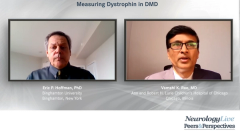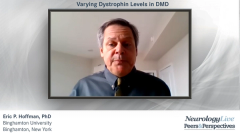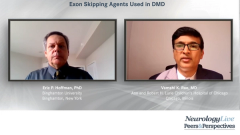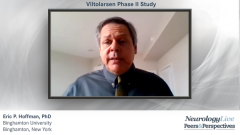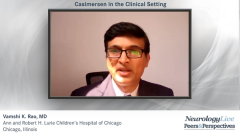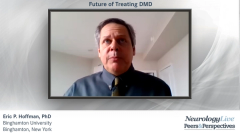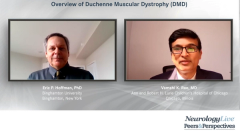
Viltolarsen Phase II Study
Viltolarsen phase II study data is discussed as well as a comparison of viltolarsen to golodirsen for treatment of Duchenne muscular dystrophy.
Episodes in this series

Vamshi K. Rao, MD: We published a paper together on viltolarsen. Could you give us a few highlights about what we saw? I can start by saying that this was a phase 2 placebo study. The placebo was initially for 4 weeks, but then we switched everybody to treatment. There were 2 treatment arms: 40 mg/kg and 80 mg/kg. Could you tell us a little about what we saw in all the ways of measuring dystrophin that you beautifully alluded to before with the study for viltolarsen? What differences do you notice between viltolarsen and golodirsen when it comes to those numbers?
Eric P. Hoffman, PhD: Sure.
Vamshi K. Rao, MD: I’m sorry to force you to give us numbers.
Eric P. Hoffman, PhD: No, I’m fine with that as long as you interpret the numbers with your remarks, and specifically in terms of clinical benefit.
Vamshi K. Rao, MD: Exactly.
Eric P. Hoffman, PhD: The viltolarsen studies looked at biopsies after 6 months of weekly treatment. There was very clear evidence that the drug was hitting its target. You could see the alternative splicing happening in the muscle very clearly. That translated into easily detectable dystrophin that was drug-induced. The FDA said in a public letter that the dystrophin data are very clear. The levels varied from patient to patient, generally from 1% to 10%, with a mean of about 6% normal levels. As we talked about earlier, you’d love to get up to about 10% of the abnormal dystrophin, but 6% is certainly getting there. If you look at clinical outcomes—it’s open-label, you can speak more to the clinical outcomes than I—it seems that patients were responding, at least compared to natural history studies.
There were significant improvements in clinical outcome, but a very small number of subjects. There were 16 subjects, 8 at each dose. These are not big studies, and they’re not powered for clinical benefit. Those in an accelerated approval have to be done post-marketing. In fact, the company, NS Pharma, Inc is doing a larger placebo-controlled study post-marketing with the major outcome of clinical benefit. That trial is not measuring dystrophin levels, because it is just for approval under an accelerated pathway. That’s good for the patients because you don’t want to take a lot of biopsies from the patients.
In terms of benchmarking viltolarsen to golodirsen, which is the Sarepta therapeutics drug, you can just look at how much dystrophin they’re making. What’s published in the FDA materials for golodirsen is about 1% drug-induced dystrophin, whereas for viltolarsen, the FDA documents and publications say about 6% increase in dystrophin. At first blush, it seems that the 6% is probably on average better than the 1%, but all these have to be borne out in clinical studies post-marketing. As I said before, we expect different patients to respond differently. You can’t directly equate a number of dystrophin with clinical improvement. You’re going to find some patients in whom 6% dystrophin has an enormous clinical benefit, and some in whom it may not show much.
Vamshi K. Rao, MD: That’s a very important point. You could have dystrophin levels that are lower with a higher benefit, and higher with a lower benefit. That connection is very difficult to make. I can tell you from personal experience that talking to families about numbers and clinical outcomes is a very nuanced conversation.
I thank all of you for watching this NeurologyLive® Peers & Perspectives®. If you enjoyed the content, please subscribe to our newsletters to receive upcoming programs and other great content in your inbox. Thank you.
Transcript Edited for Clarity
Newsletter
Keep your finger on the pulse of neurology—subscribe to NeurologyLive for expert interviews, new data, and breakthrough treatment updates.


